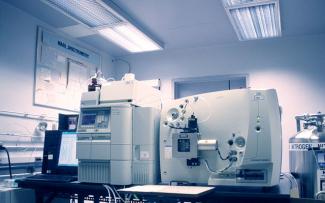
The Mass Spectrometry Facility is part of the Shared Instrument Facilities of the Department of Chemistry. It provides low and high resolution mass spectra to Penn Chemistry and to other research groups throughout the university community for the determination of elemental composition and purity of a wide variety of compounds. The facility director is Dr. Charles W. Ross III. and is comprised of the following:
- A Waters SQD equipped with an Acquity UPLC. This is a user operated instrument for obtaining low resolution mass spectra of polar samples using the electro spray ionization (ESI) technique. It is generally used by synthetic organic chemists for rapid survey work in the 150 - 2000 amu range and occasionally for the analysis of larger biomolecules by detection of multiply charged species. Almost every researcher is trained on its use. It is available twenty four hours a day, seven days a week, and analyzes roughly 8000 samples a year.
- An Agilent 5973 GCMS. The GCMS is used by researchers to obtain low resolution mass spectra of small volatile compounds (500 amu) or mixtures using the CI method of ionization. The instrument was installed in 2002 and analyzes about 500 samples a year.
- A Waters LCT Premier XE LC/MS system and a Waters GC-TOF Premier. The LCT Premier is a high-resolution orthogonal time-of-flight (oa-TOF) analyzer with both APCI and ESI ionization capability. This instrument may expand from conventional V to W geometry, thereby enhancing resolution. Its function is complimented by the GC-TOF for analysis of samples that can be volatilized and detected by use of gas phase CI. Both these instruments are capable of automated exact mass measurements.
- A Bruker MALDI-TOF-TOF. This instrument was acquired recently with the purpose of allowing the facility to expand service to its present users and to attract new applications, particularly those of researchers who are doing work at the interface of chemistry and bioscience. This instrument is capable of analyzing peptides, proteins, tRNA, oligonucleotides, and synthetic polymers.
